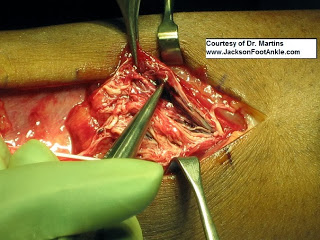Achilles Tendon Rupture (PARS) repair
- Katie Zweck
- Aug 29, 2021
- 2 min read
Achilles ruptures are a frequently encountered foot and ankle injury. It occurs when there is sudden dorsiflexion of a plantarflexed foot. These are most commonly associated with sporting events but can occur in the average non-athlete population as well, especially when the achilles tendon is degenerated.

Achilles tendon has a watershed area located about 4-6 cm above its insertion on the heel bone. Ruptures commonly occur in this location due its relative avascularity. Patients usually hear a “pop” when the injury happens. Pain and weakness is almost immediate with difficulty in ambulation.
Physical exam shows a palpable gap in the usual smooth tendinous surface on the posterior leg. When the gastroc-soleus (calf) muscle complex is manually compressed there is lack of plantarflexion. This is referred to as the Thompson test. Weakness in plantarflexion is also noticeable.

X-rays are almost always taken in lower extremity trauma. They usually show a soft tissue defect but are not detailed enough. MRI is the gold standard imaging study. This is required for diagnosis and more importantly surgical planning.
Many surgical treatment options are available depending on the length of the deficit. Percutaneous Achilles Repair System (PARS) by Arthrex is a novel MIS technique to perform a primary repair of the achilles tendon. This technique minimizes recovery and wound complications. The surgical incision is also much smaller in comparison to traditional incisions.
Postoperatively patients are placed in a gravity equinus cast or splint with Non-weight bearing. Over time the foot is brought to neutral giving the achilles tendon time to heal. Physical therapy is often utilized in the postoperative course.
Below is 2 case studies of a PARS technique with above illustration vs a step by step open repair case. Either percutaneous vs open our surgeons are available and experienced















Comentarios